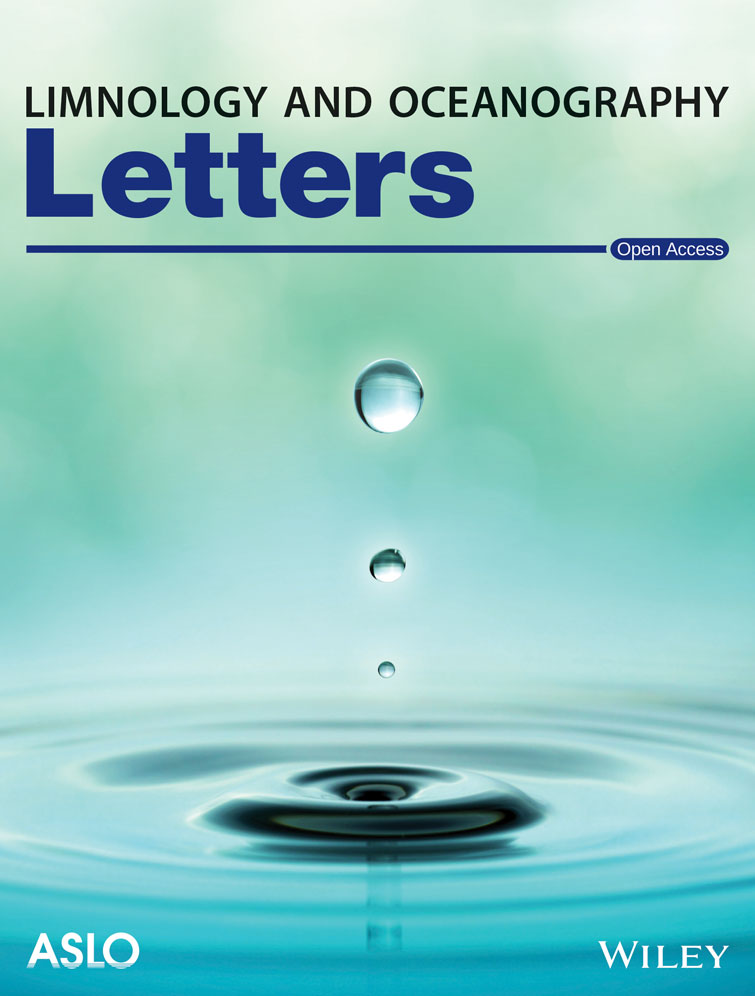在许多湖泊中,二氧化碳通量的日变化很大
IF 5
2区 地球科学
Q1 LIMNOLOGY
引用次数: 0
摘要
湖泊作为二氧化碳的源和汇,在全球碳循环中发挥着重要作用。湖泊的CO2通量(FCO2)的现场测量通常是在白天收集的,尽管有明显的昼夜变化迹象。当按比例放大到整个湖泊的年度水生碳预算时,这就引入了偏差。我们进行了一项国际抽样计划,以确定湖泊中FCO2的昼夜变化程度。我们在41个活动中对21个湖泊进行了采样,并在整个昼夜循环中每隔4小时测量FCO2。FCO2的速率范围为−3.16 ~ 4.39 mmol m−2 h−1。在一天内,整个活动的FCO2范围为- 381.68至878.49 mg cm - 2 d - 1(平均值= 76.54)。我们确定了与营养状态相关的FCO2的三种特征日模式,并表明在一半的活动中,如果基于单一(白天)测量,日通量估计偏差为50%。本文章由计算机程序翻译,如有差异,请以英文原文为准。
Diel variation in CO2 flux is substantial in many lakes
Lakes play a significant role in the global carbon cycle, acting as sources and sinks of carbon dioxide (CO2 ). In situ measurements of CO2 flux (FCO2 ) from lakes have generally been collected during daylight, despite indications of significant diel variability. This introduces bias when scaling up to whole‐lake annual aquatic carbon budgets. We conducted an international sampling program to ascertain the extent of diel variation in FCO2 across lakes. We sampled 21 lakes over 41 campaigns and measured FCO2 at 4‐h intervals over a full diel cycle. Rates of FCO2 ranged from −3.16 to 4.39 mmol m−2 h−1 . Integrated over a day, FCO2 ranged from −381.68 to 878.49 mg C m−2 d−1 (mean = 76.54) across campaigns. We identified three characteristic diel patterns in FCO2 related to trophic status and show that for half of the campaigns, daily flux estimates were biased by > 50% if based on a single (daytime) measurement.
求助全文
通过发布文献求助,成功后即可免费获取论文全文。
去求助
来源期刊

Limnology and Oceanography Letters
Multiple-
CiteScore
10.00
自引率
3.80%
发文量
63
审稿时长
25 weeks
期刊介绍:
Limnology and Oceanography Letters (LO-Letters) serves as a platform for communicating the latest innovative and trend-setting research in the aquatic sciences. Manuscripts submitted to LO-Letters are expected to present high-impact, cutting-edge results, discoveries, or conceptual developments across all areas of limnology and oceanography, including their integration. Selection criteria for manuscripts include their broad relevance to the field, strong empirical and conceptual foundations, succinct and elegant conclusions, and potential to advance knowledge in aquatic sciences.
 求助内容:
求助内容: 应助结果提醒方式:
应助结果提醒方式:


